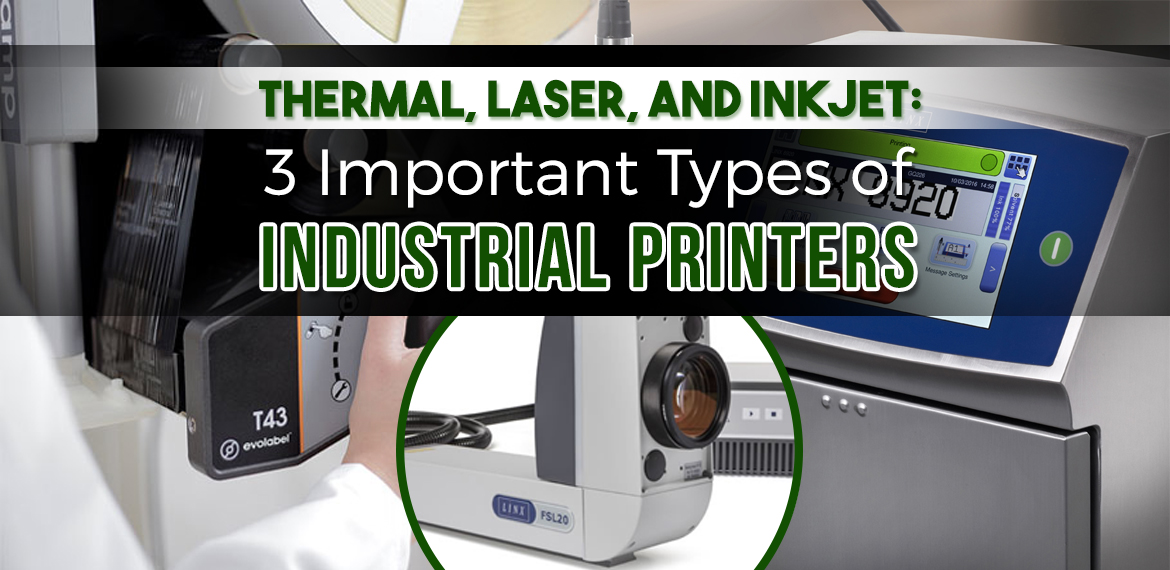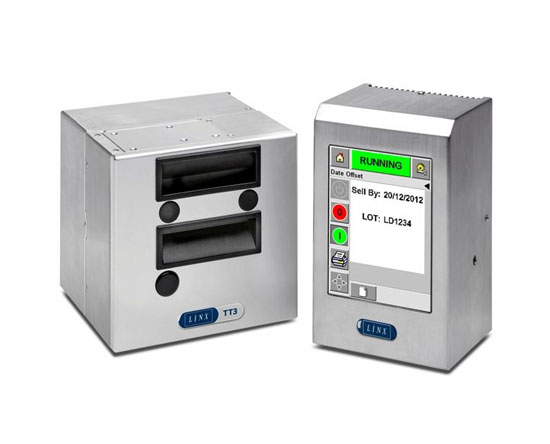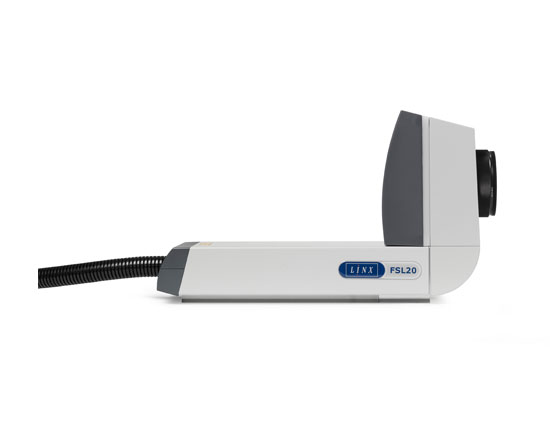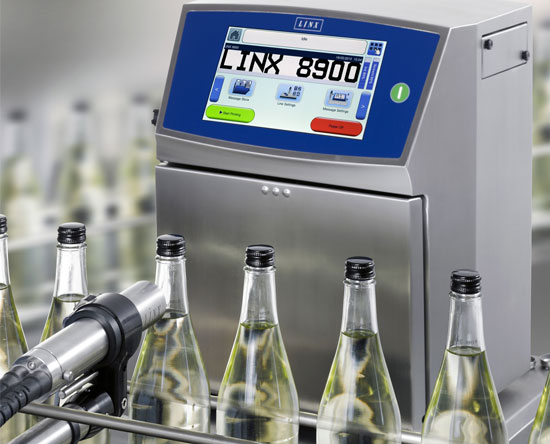Is your company looking for a coder or printer for its assembly line? You’ll need to learn to differentiate thermal printers, laser coders, and inkjet printers, otherwise you might use one where you need another. To help you make an informed purchase, here’s a rundown on the basic workings and applications of each type. This guide also includes suggested products for each type of printer.
Thermal Printers
Thermal printers use small heating elements to either activate or transfer ink onto the substrate. They do not need ink or toner, yet their prints can survive rain, sun exposure, and extreme temperatures. There are two types of thermal printers:
- Direct thermal printers use chemically-treated paper, which darkens to form print when heated. They don’t require ink, toner, or ribbons to operate.
- Thermal transfer overprinters (TTOs) use solid wax-based ink ribbons. A thermal print head heats up the ribbon, causing the ink to melt onto the substrate and create a permanent print.
Applications
Clean and user-friendly, thermal printers can easily print clear and highly scannable code while producing minimal waste, if any. Thermal transfer overprinters are especially well-suited for plastic, foil, gloss card, and label stock. Also, top-notch TTOs can print just about anything, from prices to QR codes to ingredients.
Featured Thermal Printers
Thinking of choosing a thermal printer? Here are some thermal transfer overprinters that might fit your assembly line.
If you want to cut down on print wastage, the Linx TT3 might be the thermal printer for you. Its efficient ribbon drive and 35mm printhead can code on 32mm x 30mm areas. This printer’s user-friendly design includes a ribbon cassette system for fast changeovers and a color touch screen.
The versatile Linx TT5 comes with a 55mm ribbon width, making it suitable for packaging printing. It can easily take on most date coding jobs.
Need to print logos or ingredients on your products? The Linx TT10 can help you out with its 110mm ribbon width. Use it to print marketing information and longer messages as well.
Laser Coders and Markers
These machines remove a thin layer of material and then use a laser to engrave the needed codes on the fresh patch. The exact process depends on the substrate. For example, plastic is made to melt or change color to leave a mark, while glass is coded with micro cracks which do not affect the rest of the packaging. This results in indelible marks that last as long as the product itself.
Applications
Laser coders are ideal for anti-counterfeiting measures and brand protection barcodes. With a range of lenses and beam strengths, these coders can be matched to meet line speed requirements whether they’re marking on carton, plastic, glass, or metal.
Featured Laser Coders
Need a high-quality laser coder and marker? Here’s a list of Linx laser coders to start you off.
Want your products to have anti-counterfeiting features? Include either of these fiber laser printers on your assembly line. With a fine spot size, these coders can squeeze large amounts of data into a small area, whether you’re printing on plastic or packaging foil. Choose between the 20-watt FSL20 and the 50-watt FSL50.
If you’re looking for a fast and compact printer that won’t hurt the company budget, consider giving the Linx SL1 a try. Lightweight and reliable, the Linx SL1 can print logos and QR codes, as well as mix logos, text, and machine-readable codes into one message.
The versatile Linx CSL60 can code on glass and rubber and reach line widths of up to 601mm. Machines with IP54 ratings are readily available, while an option with a IP65 rating can survive washdown environments. Avail of a 9.3 μm tube, and your coder will still produce clear marks on fast moving PET lines.
- Linx CSL10 and CSL30
Whether your codes are simple or complex, these two printers can cover your printing needs while reaching line speeds of up to 900m/min. They can code in tight spaces and in any orientation thanks to detachable marking heads and several beam delivery options.
Fast and powerful, the Linx SLHP can leave 2D codes and other pharmaceutical codes on PVC, PET, glass, and rubber, as well as reach up to 70,000 bottles per hour. It is useful for anti-counterfeiting, making it a suitable coder for liquor, perfumes, car parts, tobacco, and other premium goods.
Inkjet Printers
Industrial inkjet printers spray thousands of ink droplets onto paper, which are combined to form text or images. Depending on the DPI (dots per inch) specified beforehand, the printer can use smaller ink droplets and produce sharper images. Inkjet printers come in two varieties:
- Continuous inkjet printers (CIJs) use a continuous stream of ink which is broken into droplets by a piezoelectric crystal. Some of the droplets are then electrically charged and deflected onto the substrate, while other droplets are recycled back into the stream.
- Drop-on-demand inkjet printers (DODs) only print the ink that will be used.
Applications
Industrial inkjet printers are perfectly capable of high quality prints on virtually any substrate. Continuous inkjet printers in particular can quickly print large quantities of codes and labels. Use a CIJ to print batch codes, logos, and dates and times onto your products.
Featured Inkjet Printers
Do you think your assembly line could use an inkjet printer? Here are a few continuous inkjet printers you can choose from.
These two continuous inkjet printers are both flexible and user-friendly. The Linx 8900 can print barcodes, QR codes, and characters from 1.8mm to 8.8mm in height at a speed of 2.92m/s, while the Linx 8910 can reach a maximum print height of 20mm and a line speed of 6.25m/s. Both printers can print up to 3 lines of text at once.
The Linx 8920 is built for speed. Not only does it have a maximum print height of 20mm like the Linx 8910, but it can print up to 5 lines of text at a speed of 7.28m/s.
With an IP55 rating and a line speed of 9.10m/s, the Linx 8940 can take on high-volume printing applications in tough and dusty workplaces. An IP65-rated option is available for assembly lines with especially harsh environments. Like the 8920, the 8940 can print up to 5 lines of text at once.
Need to include graphics or QR codes on your packaging? Consider including the Linx 7900 on your assembly line. You can also upload and download messages via PC and monitor the printer through a smartphone thanks to Linx Insight® software.
ALSO READ: Cobot Basics: 5 Differences Between Collaborative Robots and Traditional Robots
At this point, you might have an idea of what industrial coders and printers your company will need for its assembly line. However, it still helps to consult an expert with in-depth knowledge of industrial equipment before making your purchase.
For the past 25 years and counting, Elixir Industrial Equipment, Inc. has supplied its customers in the Philippines with printers and coders from World Class industry leaders such as Linx Printing UK. Professional post-sales service is also part of Elixir’s commitment to its customers. Contact us today, and we can help you find the industrial printer that best suits your applications.
Found this post helpful? Visit our blog regularly for more informative articles about coders and printers, as well as other industrial equipment.




